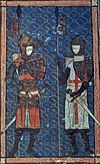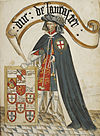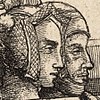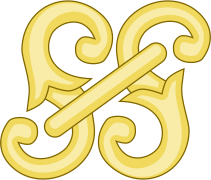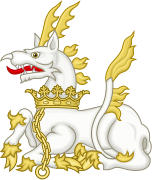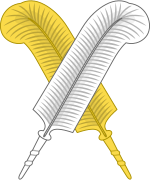House of Lancaster
| House of Lancaster | |
|---|---|
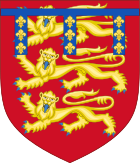 First house[a]  Second house[b] | |
| Parent house | House of Plantagenet |
| Country | |
| Founded | 1267 |
| Founder | Edmund Crouchback, 1st Earl of Lancaster and Leicester (first house) John of Gaunt, 1st Duke of Lancaster (second house) |
| Current head | Extinct |
| Final ruler | Henry of Grosmont, 1st Duke of Lancaster (first house) Henry VI of England (second house) |
| Estate(s) | England |
| Dissolution | 1361 (last unbroken male heir) 1471 (extinction) |
| Deposition | 1461 (first time) 1471 (final time and extinction) |
| Cadet branches |
|
The House of Lancaster was a cadet branch of the royal House of Plantagenet. The first house was created when King Henry III of England created the Earldom of Lancaster—from which the house was named—for his second son Edmund Crouchback in 1267. Edmund had already been created Earl of Leicester in 1265 and was granted the lands and privileges of Simon de Montfort, 6th Earl of Leicester, after de Montfort's death and attainder at the end of the Second Barons' War.[1] When Edmund's son Thomas, 2nd Earl of Lancaster, inherited his father-in-law's estates and title of Earl of Lincoln he became at a stroke the most powerful nobleman in England, with lands throughout the kingdom and the ability to raise vast private armies to wield power at national and local levels.[2] This brought him—and Henry, his younger brother—into conflict with their cousin King Edward II, leading to Thomas's execution. Henry inherited Thomas's titles and he and his son, who was also called Henry, gave loyal service to Edward's son King Edward III.
The second house of Lancaster was descended from John of Gaunt, who married the heiress of the first house, Blanche of Lancaster. Edward III married all his sons to wealthy English heiresses rather than following his predecessors' practice of finding continental political marriages for royal princes. Henry of Grosmont, 1st Duke of Lancaster, had no male heir so Edward married his son John to Henry's heiress daughter and John's third cousin Blanche of Lancaster. This gave John the vast wealth of the House of Lancaster. Their son Henry usurped the throne in 1399, creating one of the factions in the Wars of the Roses. There was an intermittent dynastic struggle between the descendants of Edward III. In these wars, the term Lancastrian became a reference to members of the family and their supporters. The family provided England with three kings: Henry IV (r. 1399–1413), Henry V (r. 1413–1422), and Henry VI (r. 1422–1461 and 1470–1471).
The house became extinct in the male line upon the death or murder in the Tower of London of Henry VI, following the battlefield execution of his son Edward of Westminster, Prince of Wales, by supporters of the House of York in 1471. Lancastrian cognatic descent—from John of Gaunt and Blanche of Lancaster's daughter Philippa—continued in the royal houses of Spain and Portugal while the Lancastrian political cause was maintained by Henry Tudor—a relatively unknown scion of the Lancastrian Beauforts—eventually leading to the establishment of the House of Tudor. The Lancastrians left a legacy through the patronage of the arts, most notably in founding Eton College and King's College, Cambridge. However, to historians' chagrin, it is Shakespeare's partly fictionalized history plays rather than medievalist scholarly research that has the greater influence on modern perceptions of the dynasty.[3]
Origin of the Earls of Lancaster
[edit]After the supporters of Henry III of England suppressed opposition from the English nobility in the Second Barons' War, Henry granted to his second son Edmund Crouchback the titles and possessions forfeited by attainder of the barons' leader, Simon de Montfort, 6th Earl of Leicester, including the Earldom of Leicester, on 26 October 1265. Later grants included the first Earldom of Lancaster on 30 June 1267 and that of Earl Ferrers in 1301. Edmund was also Count of Champagne and Brie from 1276 by right of his wife.[1] Henry IV of England would later use his descent from Edmund to legitimise his claim to the throne, even making the spurious claim that Edmund was the elder son of Henry but had been passed over as king because of his deformity.[4]

Edmund's second marriage to Blanche of Artois, the widow of the King of Navarre, placed him at the centre of the European aristocracy. Blanche's daughter Joan I of Navarre was queen regnant of Navarre and through her marriage to Philip IV of France was queen consort of France. Edmund's son Thomas became the most powerful nobleman in England, gaining the Earldoms of Lincoln and Salisbury through marriage to the heiress of Henry de Lacy, 3rd Earl of Lincoln. His income was £11,000 per annum—double that of the next wealthiest earl.[2]
Thomas and his younger brother Henry served in the coronation of their cousin King Edward II of England on 25 February 1308; Thomas carried Curtana, the Sword of Mercy, and Henry carried the royal sceptre.[5] After initially supporting Edward, Thomas became one of the Lords Ordainers, who demanded the banishment of Piers Gaveston and the governance of the realm by a baronial council. After Gaveston was captured, Thomas took the lead in his trial and execution at Warwick in 1312.[6] Edward's authority was weakened by poor governance and defeat by the Scots at the Battle of Bannockburn. This allowed Thomas to restrain Edward's power by republishing the Ordinances of 1311. Following this achievement Thomas took little part in the governance of the realm and instead retreated to Pontefract Castle.[7] This allowed Edward to regroup and re-arm, leading to a fragile peace in August 1318 with the Treaty of Leake. In 1321 Edward's rule again collapsed into civil war. Thomas raised a northern army but was defeated and captured at the Battle of Boroughbridge in March 1322. He was sentenced to be hanged, drawn and quartered but because he was Edward's cousin he was given a quicker death by beheading.[8]
Henry joined the revolt of Edward's wife Isabella of France and Mortimer in 1326, pursuing and capturing Edward at Neath in South Wales.[8] Following Edward's deposition at the Parliament of Kenilworth in 1326 and reputed murder at Berkeley Castle,[9] Thomas's conviction was posthumously reversed and Henry regained possession of the Earldoms of Lancaster, Derby, Salisbury and Lincoln that had been forfeit for Thomas's treason. His restored prestige led to him knighting the young King Edward III of England before his coronation.[10] Mortimer lost support over the Treaty of Edinburgh–Northampton that formalised Scotland's independence, and his developing power in the Welsh Marches provoked jealousy from the barons. When Mortimer called a parliament to make his new powers and estates permanent with the title of Earl of March in 1328, Henry led the opposition and held a counter-meeting. In response, Mortimer ravaged the lands of Lancaster and checked the revolt. Edward III was able to assume control in 1330 but Henry's further influence was restricted by poor health and blindness for the last fifteen years of his life.[11]
Duchy and Palatinate of Lancaster
[edit]| English Royalty |
| Second House of Lancaster |
|---|
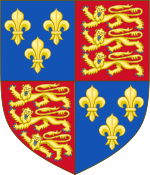 |
| John, Duke of Lancaster |
| Henry IV |
| Henry V |
| Henry VI |
Henry's son, also named Henry, was born at the castle of Grosmont in Monmouthshire between 1299 and 1314.[12] According to the younger Henry's memoirs, he was better at martial arts than academic subjects and did not learn to read until later in life.[13] Henry was coeval with Edward III and was pivotal to his reign, becoming his best friend and most trusted commander.[14] Henry was knighted in 1330, represented his father in parliament and fought in Edward's Scottish campaign.[15] After the outbreak of the Hundred Years' War, Henry took part in several diplomatic missions and minor campaigns and was present at the great English victory in the naval Battle of Sluys in 1340.[16] Later, he was required to commit himself as hostage in the Low Countries for Edward's considerable debts. He remained hostage for a year and had to pay a large ransom for his own release.[17]
In 1345, Edward III launched a major, three-pronged attack on France. The Earl of Northampton attacked from Brittany, Edward from Flanders, and Henry from Aquitaine in the south.[14] Moving rapidly through the country, Henry confronted the Comte d'Isle at the Battle of Auberoche and achieved a victory described as "the greatest single achievement of Lancaster's entire military career".[18] The ransom from the prisoners has been estimated at £50,000.[19] Edward rewarded Henry by including him as a founding knight of the Order of the Garter.[20] An even greater honour was bestowed on Lancaster when Edward created him Duke of Lancaster. The title of duke was relatively new in England, with only Cornwall being a previous ducal title. Lancaster was also given palatinate status for the county of Lancashire, which entailed a separate administration independent of the crown.[21] There were two other counties palatine; Durham was an ancient ecclesiastical palatinate and Chester was crown property.
In 1350, Henry was present at the naval victory at Winchelsea, where he saved the life of the Black Prince.[22] He spent 1351–2 on crusade in Prussia where a quarrel with Otto, Duke of Brunswick, almost led to a duel between the two men, which was only averted by the intervention of John II of France.[23] As campaigning in France resumed, Henry participated in the last great offensive of the Rheims campaign of 1359–60—the first phase of the Hundred Years' War—before returning to England where he fell ill and died, most likely of the plague, at Leicester Castle.[24]
Edward III of England married John of Gaunt, his third surviving son, to Henry's heiress Blanche of Lancaster. On Henry's death, Edward conferred on Gaunt the second creation of the title of Duke of Lancaster, which made Gaunt, after Edward, the wealthiest landowner in England. Gaunt enjoyed great political influence during his lifetime, but upon his death in 1399 his lands were confiscated by Richard II. Gaunt's exiled son and heir Henry of Bolingbroke returned home and gathered military support in clear contravention of Richard's treason act of 1397, which included a definition of treason of "or [to] ... raiseth People and rideth against the King to make War within his Realm ...". Although he claimed his aim was restoration of his Lancaster inheritance, this Act and Henry's knowledge of Richard's character—suspicious and vindictive—probably meant Henry knew that only by removing Richard from power could he be secure.[25] Henry unified popular opposition to Richard II, took control of the kingdom and Richard—recognising that he had insufficient support to resist—surrendered to Henry's forces at Conwy Castle. Henry instigated a commission to decide who should be king. Richard was forced to abdicate and although Henry was not next in line, he was chosen by an unlawfully constituted parliament dominated by his supporters.[26] After the first unrest of his reign and a revolt by the Earls of Salisbury, Gloucester, Exeter and Surrey, Richard reputedly starved to death.[27] There is some debate as to whether this was self-inflicted or ordered by Henry to end the risk of restoration without leaving incriminating marks on the body.[28]
Reign of Henry IV
[edit]There is much debate among historians about Henry's accession, in part because some see it as a cause of the Wars of the Roses. For many historians, the accession by force of the throne broke principles the Plantagenets had established successfully over two and a half centuries and allowed any magnate with sufficient power and Plantagenet blood to have ambitions to assume the throne. Richard had attempted to disinherit Henry and remove him from the succession. In response, Henry's legal advisors, led by William Thirning, dissuaded Henry from claiming the throne by right of conquest and instead look for legal justification.[29] Although Henry established a committee to investigate his assertion that his mother had legitimate rights through descent from Edmund Crouchback, who he said was the elder son of Henry III of England but was set aside because of deformity, no evidence was found. The eight-year-old Edmund Mortimer, Earl of March, was the heir general to Richard II by being the great-grandson of Edward III's second son, Lionel of Antwerp, 1st Duke of Clarence, and also the son of Richard's last nominated heir. In desperation, Henry's advisors made the case that Henry was heir male to Henry III and this was supported by thirteenth-century entails.[30] Mortimer's sister Anne de Mortimer married Richard of Conisburgh, 3rd Earl of Cambridge, son of Edward III's fourth son Edmund of Langley, consolidating Anne's place in the succession with that of the more junior House of York.[31] As a child, Mortimer was not considered a serious contender and, as an adult, he showed no interest in the throne. He instead loyally served the House of Lancaster. Mortimer informed Henry V when Conisburgh, in what was later called the Southampton Plot, attempted to place him on the throne instead of Henry's newly crowned son—their mutual cousin—leading to the execution of Conisburgh and the other plotters.[32]
Henry IV was plagued with financial problems, the political need to reward his supporters, frequent rebellions and declining health—including leprosy and epilepsy.[33] The Percy family had been some of Henry's leading supporters, defending the North from Scotland largely at their own expense, but revolted in the face of lack of reward and suspicion from Henry. Henry Percy (Hotspur) was defeated and killed at the Battle of Shrewsbury. In 1405, Hotspur's father Henry Percy, 1st Earl of Northumberland, supported Richard le Scrope, Archbishop of York, in another rebellion, after which the elder Percy fled to Scotland and his estates were confiscated. Henry had Scrope executed in an act comparable to the murder of another Archbishop—Thomas Becket—by men loyal to Henry II. This would probably have led to Henry's excommunication, but the church was in the midst of the Western Schism, with competing popes keen on Henry's support; it protested but took no action.[34] In 1408, Percy invaded England once more and was killed at the Battle of Bramham Moor.[35] In Wales, Owain Glyndŵr's widespread rebellion was only suppressed with the recapture of Harlech Castle in 1409, although sporadic fighting continued until 1421.[36]
Henry IV was succeeded by his son Henry V,[37] and eventually by his grandson Henry VI in 1422.[38]
Henry V and the Hundred Years' War
[edit]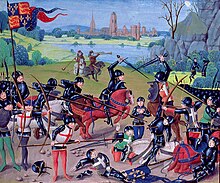
Henry V of England was a successful and ruthless monarch.[39] He was quick to re-assert the claim to the French throne he inherited from Edward III, continuing what was later called the Hundred Years' War. The war was not a formal, continuous conflict but a series of English raids and military expeditions from 1337 until 1453. There were six major royal expeditions; Henry himself led the fifth and sixth, but these were unlike the smaller, frequent, provincial campaigns.[40] In Henry's first major campaign—and the fifth major royal campaign of the war—he invaded France, captured Harfleur, made a chevauchée to Calais and won a near-total victory over the French at the Battle of Agincourt despite being outnumbered, outmanoeuvred and low on supplies.[41] In his second campaign, he recaptured much of Normandy and in a treaty secured a marriage to Catherine of Valois. The terms of the Treaty of Troyes were that Henry's and Catherine's heirs would succeed to the throne of France. This condition was contested by the Dauphin and the momentum of the war changed. In 1421, Henry's brother Thomas, Duke of Clarence, was killed at the Battle of Baugé, and Henry V died of dysentery at Vincennes in 1422.[38][42]
Henry VI of England was less than a year old but his uncles—led by Henry V's brother John of Lancaster, 1st Duke of Bedford—continued the war.[43] There were more victories, including the Battle of Verneuil, but it was impossible to maintain campaigning at this level given the relative economic and manpower resources of England against France. Joan of Arc's involvement helped the French remove the siege of Orleans[44] and win the Battle of Patay before Joan was captured by the Burgundians, sold to the English, tried as a witch and burnt at the stake. The Dauphin was crowned and continued the successful Fabian tactics of avoiding full frontal assault and exploiting logistical advantage.[45]
Henry VI and the fall of the House of Lancaster
[edit]The Hundred Years' War caused political division between the Lancastrians and the other Plantagenets during the minority of Henry VI: Bedford wanted to maintain the majority of the Lancastrians' French possessions; Humphrey of Lancaster, 1st Duke of Gloucester wanted to hold only Calais; and Cardinal Beaufort desired a negotiated peace.[46] Gloucester's attacks on Beaufort forced the latter from public life but brought him little advantage as the Earl of Suffolk's influence over the king enabled him to direct policy for the rest of the decade. Gloucester remained heir presumptive but in 1441 his ambitious wife, Eleanor Cobham, consulted astrologers on the likelihood of the king's death and was arrested for treasonable necromancy—although Gloucester was not implicated he was discredited forced into retirement. In 1447 Suffolk had him arrested and within days he died in prison.[47]
England's ally Philip III, Duke of Burgundy defected to Charles when the English ambassadors' refusal to renounce the claim to the French crown stalled negotiations, signing the Treaty of Arras (1435).[48] The French reorganised the superior numbers of their feudal levies into a modern professional army and retook Paris, Rouen, Bordeaux and Normandy. Victories at the Battle of Formigny in 1450 and the Battle of Castillon in 1453 brought the war to an end with the House of Lancaster losing forever all its French holdings, except Calais and the Channel Islands.[49]
Henry VI proved to be a weak king and vulnerable to the over-mighty subjects who developed private armies of retainers. Rivalries often spilled over from the courtroom into armed confrontations, such as the Percy–Neville feud.[50] Without the common purpose of the war in France, Henry's cousin Richard of York, 3rd Duke of York, and Richard Neville, 16th Earl of Warwick, used their networks to defy the crown.[51] Henry became the focus of discontent as the population, agricultural production, prices, the wool trade and credit declined in the Great Slump.[52] This led to radical demands from the lower classes. In 1450, Jack Cade raised a rebellion to force Henry to address the economic problems or abdicate his throne.[53] The uprising was suppressed but conflict remained between villagers, gentry and aristocracy. Society remained deeply unsettled and radical demands continued to be suppressed such as those from the yeoman brothers John and William Merfold.[54]

Henry's marriage to Margaret of Anjou prompted criticism from Richard Plantagenet, Duke of York, because it included the surrender of Maine and an extended truce with France. York was Henry's cousin through his descent from Edward III sons Lionel of Antwerp, 1st Duke of Clarence, and Edmund, Duke of York. This gave York political influence but he was removed from English and French politics through his appointment as Lord Lieutenant of Ireland.[55] On returning to England, York was conscious of the fate of Henry's uncle Humphrey at the hands of the Beauforts and suspicious that Henry intended to nominate Edmund Beaufort, 2nd Duke of Somerset, as heir presumptive, and recruited military forces. Armed conflict was avoided because York lacked aristocratic support and was forced to swear allegiance to Henry. However, when Henry later underwent a mental breakdown, York was named regent. Henry was trusting and not a man of war, but Margaret was more assertive and showed open enmity towards York—particularly after the birth of a male heir that resolved the succession question and assured her position.[56]
According to historian Robin Storey, "If Henry's insanity was a tragedy; his recovery was a national disaster".[57] When Henry's sanity returned, the court party reasserted its authority but York and his relatives, the Nevilles, defeated them at the First Battle of St Albans. Historian Anthony Goodman suggests that around 50 men were killed; among them were Somerset and two Percy lords, Henry Percy, 2nd Earl of Northumberland, and Thomas Clifford, 8th Baron de Clifford, creating feuds that would confound reconciliation attempts despite the shock to the ruling class caused by the armed conflict.[58] Threatened with treason charges and lacking support, York, Richard Neville, 5th Earl of Salisbury, and Richard Neville, 16th Earl of Warwick, fled abroad. Henry was captured by the opposition when the Nevilles returned and won the Battle of Northampton.[59] York joined them, surprising parliament by claiming the throne and then forcing through the Act of Accord stating that Henry would remain as monarch for his lifetime and that York would succeed him. The disinheriting of Henry's son Edward was unacceptable to Margaret so the conflict continued. York was killed at the Battle of Wakefield and his head was displayed at Micklegate Bar, York, along with those of Edmund, Earl of Rutland, and Richard Neville, Earl of Salisbury—both of whom were captured and beheaded.[60]
Margaret gained the support of the Scottish queen Mary of Guelders, and with a Scottish army she pillaged into southern England.[61] The citizens of London feared the city being plundered and enthusiastically welcomed York's son Edward, Earl of March.[62] Margaret's defeat at the Battle of Towton confirmed Edward's position and he was crowned.[63] Disaffected with Edward's marriage to Elizabeth Woodville and preferment of her formerly Lancastrian-supporting family, Warwick and Clarence defected to the Lancastrians. The alliance was sealed with the marriage of Henry's son Edward to Anne, Warwick's daughter. Edward and Richard, Duke of Gloucester, fled England. When they returned, Clarence switched sides at the Battle of Barnet and Warwick and his brother were killed. Henry, Margaret and Edward of Lancaster were caught at the Battle of Tewkesbury before they could escape back to France. Edward of Westminster, Prince of Wales, was executed on the battlefield and John Beaufort, Marquess of Dorset, was killed in the fighting—meaning that when his brother Edmund Beaufort, 4th Duke of Somerset, was executed two days later, the Beaufort family became extinct in the legitimate male line. The captive Henry was murdered on 21 May 1471 in the Tower of London and buried in Chertsey Abbey, extinguishing the House of Lancaster.[64]
Legacy
[edit]Shakespeare's history plays
[edit]"This royal throne of kings, this sceptr’d isle,
This earth of majesty, this seat of Mars,
This other Eden, demi-paradise,
This fortress built by Nature for herself
Against infection and the hand of war,
This happy breed of men, this little world,
This precious stone set in the silver sea,
Which serves it in the office of a wall,
Or as a moat defensive to a house
Against the envy of less happier lands;
This blessed plot, this earth, this realm, this England...
Historians have been dismayed by Shakespeare's influence on the perception of the later medieval period exceeding that of academic research.[66] While the chronology of Shakespeare's history plays runs from King John to Henry VIII, they are dominated by eight plays in which members of the House of Lancaster play a significant part, voicing speeches on a par with those in Hamlet and King Lear.[67] These plays are:
- Richard II
- Henry IV, Part 1
- Henry IV, Part 2
- Henry V
- Henry VI, Part 1
- Henry VI, Part 2
- Henry VI, Part 3
- Richard III.
According to the historian Norman Davies, the plays were constrained by the political and religious requirements of Tudor England. While they are factually inaccurate, they demonstrate how the past and the House of Lancaster are remembered in terms of myth, legend, ideas and popular misconceptions. Shakespeare avoided contentious political and religious issues to dubiously illustrate Tudor England as having rejected medieval conflict and entered an era of harmony and prosperity. The famous patriotic "sceptr'd isle" speech is voiced by John of Gaunt, a man who spent the majority of his life in Aquitaine, and is a piece of poetic licence that illustrates English prejudices. Henry V is one-sided with little sympathy for the French.[68] Many of these historical lines illustrate historical myth rather than realism.[69]
Succession
[edit]Lancastrian cognatic descent from John of Gaunt and Blanche's daughter Phillipa continued in the royal houses of Spain and Portugal.[70] The remnants of the Lancastrian court party coalesced support around Henry Tudor—a relatively unknown scion of the Beauforts. They had been amongst the most ardent supporters of the House of Lancaster and were descended illegitimately from John of Gaunt by his mistress Katherine Swynford. However John of Gaunt and Katherine subsequently married and their children were legitimated by the Pope and by Parliament during the reign of Richard II. Henry IV had tried to debar them from the succession by use of his royal prerogative to avoid competition with the House of Lancaster's claims to the throne but this was of limited effect. By some calculations of primogeniture, there were as many as 18 people—including both his mother and future wife—with what some might claim a better right to the throne. By 1510, this figure had increased with the birth of an additional 16 possible Yorkist claimants.[71]
With the House of Lancaster extinct, Henry claimed to be the Lancastrian heir through his mother Lady Margaret Beaufort. His father, Edmund Tudor, was Henry VI's maternal half-brother. In 1485, Henry Tudor united increasing opposition within England to the reign of Richard III with the Lancastrian cause to take the throne. To further legitimise his claim, Henry married Elizabeth of York—Edward IV's daughter—and promoted the House of Tudor as a dynasty of dual Lancastrian and Yorkist descent.[72]
Religion, education and the arts
[edit]
The Lancastrians were both pious and well read. Henry IV was the first English king known to have possessed a vernacular Bible, supported the canonization of John Twenge, gave a pension to the anchoress Margaret Pensax and maintained close relations with several Westminster recluses. His household accounts as king record conventional payments to large numbers of paupers (12,000 on Easter day 1406) and the intercession for him of twenty-four oratores domini regis at 2d each per day. However, his reliance on the church was both personal and political. Archbishop Arundel gave the Lancastrians vital support and carried other bishops with him. In return the church required support for religious orthodoxy against heresy. Lollards were suppressed and heresy was made a capital offence in England under the statute of De haeretico comburendo even though Henry could not afford to overly antagonize his supporters with Lollard sympathies, including those among his Lancastrian retainers.[25]
According to the author of the Gesta Henrici quinti, Henry V aimed "to promote the honour of God, the extension of the Church, the deliverance of his country and the peace and tranquillity of kingdoms". He was deeply religious, engaged with ecclesiastical issues and saw that his role as king was to honour God, extend the church, fight heresy and defend the established social order. All his victories, especially Agincourt, were attributed to divine intervention. Henry V founded Syon Abbey in 1415, as penance for his father's execution of Archbishop Scrope, and three monasteries in London: for Carthusian, Bridgettine and Celestine orders.[73] The equally devout Henry VI continued the architectural patronage begun by his father, founding Eton College and King's College, Cambridge and leaving a lasting educational and architectural legacy in buildings including King's College Chapel and Eton College Chapel.[74]
The Lancastrian regime was founded and legitimised by formal lying that was both public and official. This has been described as "a series of unconstitutional actions" based "upon three major acts of perjury".[75] The historian K.B. McFarlane found it hard "to think of another moment of comparable importance in medieval English political history when the supply of information was so effectively manipulated as it was by Henry IV on this occasion".[76] The Lancastrians patronised poets for panegyric purposes for years before Henry IV ascended the throne, including Geoffrey Chaucer who dedicated The Book of the Duchess to Blanche of Lancaster around 1368. In 1400, poets in the pay of Henry IV were directed to propaganda purposes. John Gower based his Cronica Tripertita on the official Lancastrian accounts of the usurpation:"The Record and Process of the Deposition of Richard II" from 1399. Gower also produced a number of further favourable works including "In praise of peace" which was dedicated to Henry IV.[77]
Earls and Dukes of Lancaster (first creation)
[edit]Dukes of Lancaster (second creation)
[edit]| Duke | Portrait | Birth | Marriage(s) | Death |
|---|---|---|---|---|
| John of Gaunt, 1st Duke of Lancaster[83] Earl by right of his wife, the title Duke of Lancaster was vacant because there were no male heirs. Created Duke by his father Edward III of England |
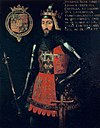
|
6 March 1340 Ghent, Flanders son of Edward III of England and Philippa of Hainault |
(1) Blanche of Lancaster 1359 7 children See above (2) Constance of Castile 21 September 1371 2 children Catherine, Queen of Castile John of Lancaster (3) Katherine Swynford 13 January 1396 4 children House of Beaufort John Beaufort, 1st Earl of Somerset Cardinal Henry Beaufort, Bishop of Winchester Thomas Beaufort, Duke of Exeter Joan Beaufort, Countess of Westmorland |
3 February 1399 Leicester Castle, Leicestershire aged 58 |
Lancastrian Kings of England
[edit]Family tree
[edit]| Family Tree: House of Lancaster |
|---|
Coats of Arms
[edit]
| Armoiries | Écu | Nom et blasonnement |
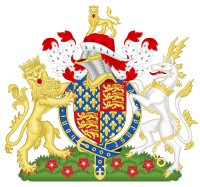
|

|
Henry IV of England (1367 † 1413), son of John of Gaunt, Duke of Lancaster grandson of Edward III of England. He deposed his cousin Richard II of England and became king.
In 1406, he simplified the French arms in imitation of Charles V :
He utilized as his supporters the lion of England and the antelope. |

|
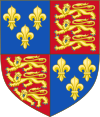
|
Henry V of England (1387 † 1422), King of England, Lord of Ireland, Duke of Aquitaine; son of Henry IV.
He utilized the lion of England and the antilope badge of his father as supporters. |

|

|
Henry VI of England (1421 † 1471), king of England, lord of Ireland, Duke of Aquitaine. In 1422, under the Treaty of Troyes, he was crowned king of France and changed his armouries.
He utilized the antelope badge of his grandfather as supporters. |
| Arms | Name | Life | Blazon | Notes |
|---|---|---|---|---|
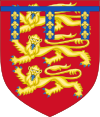 |
Edmund Crouchback, Earl of Leicester and Lancaster | 1245–1296 | Gules, three lions passant guardant Or, with a label of three points Azure each charged with three fleurs de lys Or[88] | Son of: King Henry III and Queen Eleanor. |
 |
Thomas, 2nd Earl of Lancaster | 1278–1322 | Gules, three lions passant guardant Or, with a label of three points Azure each charged with three fleurs de lys Or[88] | Son of: Edmund Crouchback, Earl of Leicester and Lancaster and Blanche of Artois. |
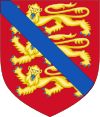 |
Henry, 3rd Earl of Lancaster | 1281–1345 | Gules, three lions passant guardant Or, a baston Azure[89] | Son of: Edmund Crouchback, Earl of Leicester and Lancaster and Blanche of Artois. |
 |
Henry of Grosmont, 1st Duke of Lancaster | 1310–1361 | Gules, three lions passant guardant Or, with a label of three points Azure each charged with three fleurs de lys Or[89] | Son of: Henry, 3rd Earl of Lancaster and Maud Chaworth |
| Arms | Name | Life | Blazon | Notes |
|---|---|---|---|---|
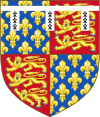 
|
John of Gaunt, Duke of Lancaster | 1340–1399 | Quarterly, 1st and 4th, France ancien, 2nd and 3rd England, with a label of three points ermine[90]
Quarterly, Castile and Leon, impaling, quarterly, France and England, a label of three points ermine[91] |
Son of: King Edward III and Queen Philippa.
See: House of Lancaster |
 |
Blanche of Lancaster | 1345–1369 | England a label of France (Old Lancaster)[90] | Daughter of: Henry of Grosmont, Duke of Lancaster and Isabel of Beaumont.
Married to: John of Gaunt, Duke of Lancaster; 1359–1369. |
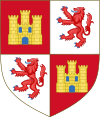 |
Constance of Castile | 1354–1394 | Quarterly, Castile and Leon (Kingdom of Castile)[91] | Daughter of: King Peter of Castile and María de Padilla.
Married to: John of Gaunt, Duke of Lancaster; 1371–1394. |
 |
Katherine Swynford | 1350–1403 | Gules, three Catherine wheels Or (Roet)[91] | Daughter of: Payne de Roet.
Married to: John of Gaunt, Duke of Lancaster; 1396–1399. |
| Colour key (Line of descent) |
|---|
Monarchs
Paternal descent
Maternal descent
Consorts
Illegitimate descent
Collaterals
|
Descendants of John of Gaunt, 1st Duke of Lancaster
[edit]| Arms | Name | Life | Blazon | Notes |
|---|---|---|---|---|
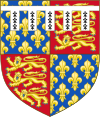 
|
Henry Bolingbroke, Duke of Hereford and Lancaster (later King Henry IV) |
1366–1413 | As Duke of Hereford:
Quarterly, 1st and 4th, France ancien, 2nd and 3rd England, with a label of five points ermine (Richmond)[92] As Duke of Lancaster and Hereford: Quarterly, 1st and 4th, France ancien, 2nd and 3rd England, with a label of five points two of ermine (Richmond) and three Azure flory Or (Lancaster)[92] |
Son of: John of Gaunt, Duke of Lancaster and Blanche of Lancaster. |
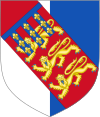 
|
John Beaufort, Earl of Somerset | 1373–1410 | Per pale, Argent and Azure, over all on a bend Gules three lions passant guardant Or with a label of three points Azure each charges with three fleur de lys Or[93]
Quarterly, 1st and 4th, France ancien, 2nd and 3rd England, within a bordure componée Argent and Azure[93] |
Illegitimate Son (legitimated in 1396) of: John of Gaunt, Duke of Lancaster and Katherine Swynford.
See: House of Beaufort |
 |
Henry Beaufort, Cardinal of St. Eusebius and Bishop of Winchester | 1374–1447 | Quarterly, 1st and 4th, France ancien, 2nd and 3rd England, within a bordure componée Argent and Azure[94] | Illegitimate Son (legitimated in 1396) of: John of Gaunt, Duke of Lancaster and Katherine Swynford. |
 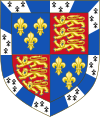
|
Thomas Beaufort, Duke of Exeter | 1377–1426 | Quarterly, 1st and 4th, France ancien, 2nd and 3rd England, within a bordure componée Azure and Ermine[95] | Illegitimate Son (legitimated in 1396) of: John of Gaunt, Duke of Lancaster and Katherine Swynford. |
Descendants of Henry IV of England
[edit]| Arms | Name | Life | Blazon | Notes |
|---|---|---|---|---|
 
|
King Henry IV | 1366–1413 | Quarterly, 1st and 4th, France ancien, 2nd and 3rd England[96]
Changed to France moderne in line with changes made in that kingdom: Quarterly, 1st and 4th, France moderne, 2nd and 3rd England[96] |
Son of: John of Gaunt, Duke of Lancaster and Blanche of Lancaster.
In 1376, the kings of France altered the royal coat of arms, replacing the field semée fleurs de lys with three fleurs de lys, alluding to the Trinity. This new design is referred to as France Moderne, the previous one being France Ancien. From about 1400 the kings of England imitated this change. As modified, the monarchs of England continued to bear arms in this form until the crown union with Scotland in 1603.[97] First king of the House of Lancaster. |
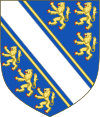 |
Mary de Bohun | 1370–1394 | Azure, a bend Argent between two cotise and six lions rampant Or (de Bohun)[92] | Daughter of: Humphrey de Bohun, Earl of Hereford and Joan FitzAlan.
Married to: Henry Bolingbroke (later King Henry IV); 1380–1394. |
 |
Joan of Navarre | 1370–1437 | Quarterly, 1st and 4th, France ancien and a baston gobony Argent and Gules (Evreux), 2nd and 3rd, Gules, a cross, a saltire and an orle of chain linked together Or (Navarre)[98] | Daughter of: King Charles II of Navarre and Joan of Valois.
Married to: King Henry IV; 1399–1413. |
| Arms | Name | Life | Blazon | Notes |
|---|---|---|---|---|
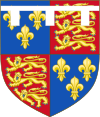 |
Henry of Monmouth, Prince of Wales (later King Henry V) |
1386–1422 | Quarterly, 1st and 4th, France moderne, 2nd and 3rd England, with a label of three points Argent[99] | Son of: King Henry IV and Mary de Bohun. |
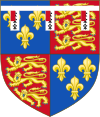 |
Thomas of Lancaster, Duke of Clarence | 1387–1421 | Quarterly, 1st and 4th, France moderne, 2nd and 3rd England, with a label of three points ermine, each with a canton Gules[100] | Son of: King Henry IV and Mary de Bohun. |
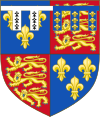 |
John of Lancaster, Duke of Bedford | 1389–1435 | Quarterly, 1st and 4th, France moderne, 2nd and 3rd England, with a label of five points, the two on the dexter side ermine and each of the other three charged with three fleurs de lys[101] | Son of: King Henry IV and Mary de Bohun. |
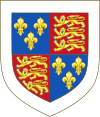 |
Humphrey of Lancaster, Duke of Gloucester | 1390–1447 | Quarterly, 1st and 4th, France moderne, 2nd and 3rd England, within a bordure Argent[101] | Son of: King Henry IV and Mary de Bohun. |
Descendants of Henry V of England
[edit]| Arms | Name | Life | Blazon | Notes |
|---|---|---|---|---|
 |
King Henry V | 1386–1422 | Quarterly, 1st and 4th, France moderne, 2nd and 3rd England[102] | Son of: King Henry IV and Mary de Bohun. |
 |
Catherine of Valois | 1401–1437 | Azure, three fleur de lys Or (France moderne)[102] | Daughter of: King Charles VI of France and Isabeau of Bavaria.
Married to: King Henry V; 1420–1422. Later married to: Owen Tudor; 1428?–1437, progenitor of the House of Tudor. |
| Arms | Name | Life | Blazon | Notes |
|---|---|---|---|---|
 |
King Henry VI | 1421–1471 | France moderne, impaling, quarterly, 1st and 4th, France moderne, 2nd and 3rd England[103] | Son of: King Henry V and Catherine of Valois.
Throne usurped by Edward, Earl of March, who became King Edward IV in 1461. |
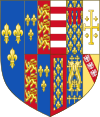 |
Margaret of Anjou | 1430–1482 | Quarterly of six, 1st, barry of eight Argent and Gules (Hungary), 2nd, Azure, semée of fleur de lys Or, a label of three points Gules (Naples), 3rd, Argent, a cross potent between four crosses Or (Jerusalem), 4th, Azure, semée of fleur de lys Or, a bordure Gules (Anjou), 5th Azure, semée of crosses crosslet fitchée, two barbels addorsée Or (Bar), 6th, Or, on a bend Gules three allerions Argent (Lorraine)[104] | Daughter of: King René of Naples, Duke of Anjou and Isabella of Lorraine.
Married to: King Henry VI; 1445–1471. |
| Arms | Name | Life | Blazon | Notes |
|---|---|---|---|---|
 |
Edward of Westminster, Prince of Wales | 1453–1471 | Quarterly, 1st and 4th, France moderne, 2nd and 3rd England, with a label of three points Argent[105] | Son of: King Henry VI and Margaret of Anjou.
Killed at the Battle of Tewkesbury 1471. |
| Colour key (Line of descent) |
|---|
Monarchs
Paternal descent
Maternal descent
Consorts
Illegitimate descent
Collaterals
|
Descendants of John Beaufort, 1st Earl of Somerset
[edit]| Arms | Name | Life | Blazon | Notes |
|---|---|---|---|---|
 
|
John Beaufort, Earl of Somerset | 1373–1410 | Per pale, Argent and Azure, over all on a bend Gules three lions passant guardant Or with a label of three points Azure each charges with three fleur de lys Or[93]
Quarterly, 1st and 4th, France ancien, 2nd and 3rd England, within a bordure componée Argent and Azure[93] |
Illegitimate Son (legitimated in 1396) of: John of Gaunt, Duke of Lancaster and Katherine Swynford. |
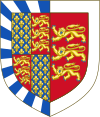
|
Margaret Holland, Countess of Somerset | 1385–1439 | Quarterly, 1st and 4th, France ancien, 2nd and 3rd England, within a bordure componée Argent and Azure, impaling, Gules, three lions passant guardant Or, within a bordure Argent[93] | Daughter of: Thomas Holland, Earl of Kent and Alice Holland, Countess of Kent
Married to: John Beaufort, Earl of Somerset; 1399–1410 Married to: Thomas of Lancaster, Duke of Clarence; 1411–1421 |
| Arms | Name | Life | Blazon | Notes |
|---|---|---|---|---|

|
John Beaufort, Duke of Somerset | 1403–1444 | Quarterly, 1st and 4th, France moderne, 2nd and 3rd England, within a bordure componée Argent and Azure[106] | Son of: John Beaufort, Earl of Somerset and Margaret Holland. |
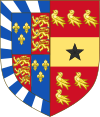
|
Margaret Beauchamp | 1406–1482 | Quarterly, 1st and 4th, France moderne, 2nd and 3rd England, within a bordure componée Argent and Azure, impaling, Gules, on a fess Or a mullet Sable, between six martlets, three, two and one, of the second (Beauchamp)[106] | Daughter of: John Beauchamp of Bletso and Edith Stourton.
Married to: Sir Oliver St John, of Bletsoe; 1425–1437. Married to: John Beaufort, Duke of Somerset; 1439–1444. Married to: Lionel de Welles, Baron Welles; 1447–1461. |
| Arms | Name | Life | Blazon | Notes |
|---|---|---|---|---|
 
|
Lady Margaret Beaufort | 1443–1509 | Quarterly, 1st and 4th, France moderne, 2nd and 3rd England, within a bordure componée Argent and Azure[107]
Quarterly, France moderne and England, a bordure Azure charged alternatively with fleurs de lys and martlets Or, impaling, Quarterly, 1st and 4th, France moderne, 2nd and 3rd England, within a bordure componée Argent and Azure[107] |
Daughter of: John Beaufort, Duke of Somerset and Margaret Beauchamp.
Married to: Edmund Tudor, 1st Earl of Richmond; 1455–1456. Married to: Sir Henry Stafford; 1462–1471. Married to: Thomas Stanley, Earl of Derby; 1472–1504. |
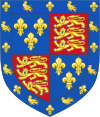
|
Edmund Tudor, Earl of Richmond | 1430–1456 | Quarterly, France moderne and England, a bordure Azure charged alternatively with fleurs de lys and martlets Or[107] | Son of: Sir Owen Tudor and Catherine of Valois.
Half brother to King Henry VI, legitimated by Parliament in 1453. |
| Arms | Name | Life | Blazon | Notes |
|---|---|---|---|---|
 
|
Henry Tudor, Earl of Richmond (later King Henry VII) |
1457–1509 | Quarterly, France moderne and England, a bordure Azure charged alternatively with fleurs de lys and martlets Or[108]
Quarterly, 1st and 4th, France moderne, 2nd and 3rd England[109] |
Son of: Edmund Tudor, Earl of Richmond and Lady Margaret Beaufort.
Defeats King Richard III at the Battle of Bosworth Field in 1485, claims the throne as King Henry VII. See: House of Tudor |
 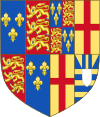
|
Elizabeth of York | 1466–1503 | Quarterly, 1st, quarterly, 1st and 4th, France moderne, 2nd and 3rd England, 2nd and 3rd de Burgh, 4th Mortimer[110] | Daughter of: King Edward IV and Elizabeth Woodville.
Married to: King Henry VII; 1486–1503. Heiress of the House of York. |
Lancaster badges
[edit]The Red Rose of Lancaster derives from the gold rose badge of Edward I of England. Other members of his family used variants of the royal badge, with the king's brother, the Earl of Lancaster, using a red rose.[111] It is believed that the Red Rose of Lancaster was the House of Lancaster's badge during the Wars of the Roses. Evidence for this "wearing of the rose" includes land tenure records requiring service of a red rose yearly for a manor held directly from Henry VI of England.[112] There are, however, doubts as to whether the red rose was actually an emblem taken up by the Lancastrians during the Wars of the Roses. Adrian Ailes has noted that the red rose "probably owes its popular usage to Henry VII quickly responding to the pre-existing Yorkist white rose in an age when signs and symbols could speak louder than words."
It also allowed Henry to invent and exploit his most famous heraldic device, the Tudor Rose, combining the so-called Lancastrian red rose and the White Rose of York. This floral union neatly symbolised the restoration of peace and harmony and his marriage in January 1486 to Elizabeth of York. It was a brilliant piece of simple heraldic propaganda."[113] The Tudor Rose is used as the plant badge of England (Scotland uses the thistle, Ireland uses the shamrock, and Wales uses the leek).
-
Red Rose Badge of Lancaster.
-
Monogram SS Badge of Henry IV.
-
Chained Antelope Badge of Henry V & VI.
-
Hereford Swan Badge of Henry V.
-
Fire Beacon Badge of Henry V.
-
Crossed Feather Badge of Henry VI.
-
Panther Badge of Henry VI.
See also
[edit]- Background information on the Act that enable the House of Lancaster to accumulate its vast holdings can be found at Quia Emptores
- Further information on the Lancastrian descent in Portugal and Spain – Philippa of Lancaster, Jorge de Lencastre, Duke of Coimbra, John of Lencastre, 1st Duke of Aveiro
- Forced marriage
- Women's history
- White Rose of York
- Alternative successions to the English Crown
Notes
[edit]- ^ As descendants of the sovereign in the male line, the earls of Lancaster bore the arms of the kingdom differenced by a label azure of three points each charged with three fleurs de lys Or. The last male of this family — Henry of Grosmont — was granted a dukedom, which was then re-created for the second house.
- ^ Arms of John of Gaunt, founder of the second house. The arms of the kingdom differenced by a label ermine. His royal descendants bore the arms undifferenced.
References
[edit]- ^ a b Weir 2008, p. 75
- ^ a b Jones 2012, p. 371
- ^ Galbraith 1982, pp. 223–239
- ^ Weir 1995, p. 40
- ^ Jones 2012, p. 363
- ^ Jones 2012, pp. 375–178
- ^ Jones 2012, p. 390
- ^ a b Jones 2012, p. 400
- ^ Davies 1999, p. 381
- ^ Jones 2012, p. 422
- ^ Waugh 2004; Lee 1997, p. 115
- ^ a b c Weir 2008, p. 77
- ^ Fowler 1969, p. 26
- ^ a b Jones 2012, p. 471
- ^ Fowler 1969, p. 30
- ^ Fowler 1969, p. 34
- ^ Fowler 1969, pp. 35–37
- ^ Fowler 1969, pp. 58–59
- ^ Fowler 1969, p. 61
- ^ McKisack 1959, p. 252
- ^ Fowler 1969, pp. 173–174
- ^ Fowler 1969, pp. 193–195
- ^ Fowler 1969, pp. 106–109
- ^ Fowler 1969, pp. 217–218
- ^ a b Brown & Summerson 2010
- ^ Weir 1995, pp. 36–39
- ^ Saul 1997, pp. 424–425
- ^ Tuck 2004, pp. 209–215
- ^ Mortimer 2012, p. 297
- ^ Mortimer 2012, pp. 298–299
- ^ Weir 1995, p. 235
- ^ Griffiths 2008.
- ^ Swanson 1995, p. 298.
- ^ Weir 1995, p. 49
- ^ Lee 1997, pp. 138–141
- ^ Davies 1995, p. 293
- ^ a b Weir 2008, p. 130
- ^ a b Weir 2008, p. 133
- ^ Schama 2000, pp. 265–266
- ^ Davies 1997, pp. 419–420
- ^ Schama 2000, p. 265
- ^ Harriss 2004a.
- ^ Stratford 2004
- ^ Davies 1999, pp. 76–80
- ^ Weir 1995, pp. 82–83
- ^ Harriss 2004b; Weir 1995, pp. 72–76
- ^ Harriss 2004b.
- ^ Weir 1995, pp. 86, 101
- ^ Weir 1995, p. 156; Weir 1995, p. 172
- ^ Schama 2000, p. 266
- ^ Castor 2000, pp. 3–22
- ^ Hicks 2010, p. 44
- ^ Weir 1995, pp. 147–155
- ^ Mate 2006, p. 156
- ^ Crofton 2007, p. 112.
- ^ Crofton 2007, p. 111
- ^ Storey 1986, p. 159
- ^ Goodman 1981, p. 25; Goodman 1981, p. 31
- ^ Goodman 1981, p. 38.
- ^ Weir 1995, p. 257
- ^ Goodman 1981, p. 57.
- ^ Goodman 1981, p. 1.
- ^ Goodman 1981, p. 147.
- ^ Weir 2008, p. 134
- ^ Davies 1999, p. 508
- ^ Davies 1999, p. 506
- ^ Davies 1999, p. 507
- ^ Davies 1999, p. 509
- ^ Belsey 1992, p. 103
- ^ Weir 2008, p. 100
- ^ Weir 2008, p. 148
- ^ Weir 2008, pp. 146–149
- ^ Allmand 2010, p. 1
- ^ Weir 1995, p. 94
- ^ Sherborne 1994, pp. 218, 239
- ^ McFarlane 1972, p. 94
- ^ Brewer 2012, p. 4
- ^ Lloyd 2004
- ^ Weir 2008, pp. 76–77
- ^ Walker 2004b.
- ^ Blanche's year of birth is a matter of scholarly debate. Loschiavo 1978
- ^ Blanche was traditionally believed to have died in 1369, but Palmer's evidence that she died the year before is now widely accepted by scholars. Palmer 1974
- ^ Walker 2004a, p. 124.
- ^ Weir 2008, p. 124
- ^ Griffiths 2004
- ^ a b c d e Maclagan, Michael; Louda, Jiří (1999). Line of Succession: Heraldry of the Royal Families of Europe. London: Little, Brown & Co. pp. 29–30. ISBN 1-85605-469-1.
- ^ a b c d e Rietstap, Johannes Baptist (1861). Armorial général, contenant la description des armoiries des familles nobles et patriciennes de l'Europe: précédé d'un dictionnaire des termes du blason. G.B. van Goor.
- ^ a b Pinches & Pinches 1974, p. 32.
- ^ a b Pinches & Pinches 1974, p. 33.
- ^ a b Pinches & Pinches 1974, p. 77.
- ^ a b c Pinches & Pinches 1974, p. 78.
- ^ a b c Pinches & Pinches 1974, p. 86.
- ^ a b c d e Pinches & Pinches 1974, p. 81.
- ^ Pinches & Pinches 1974, p. 84.
- ^ Pinches & Pinches 1974, p. 85.
- ^ a b Pinches & Pinches 1974, p. 87.
- ^ Brooke-Little 1978, pp. 205–222.
- ^ Pinches & Pinches 1974, p. 89.
- ^ Pinches & Pinches 1974, p. 94.
- ^ Pinches & Pinches 1974, p. 91.
- ^ a b Pinches & Pinches 1974, p. 92.
- ^ a b Pinches & Pinches 1974, p. 95.
- ^ Pinches & Pinches 1974, p. 97.
- ^ Pinches & Pinches 1974, p. 99.
- ^ Pinches & Pinches 1974, p. 100.
- ^ a b Pinches & Pinches 1974, p. 82.
- ^ a b c Pinches & Pinches 1974, p. 127.
- ^ Pinches & Pinches 1974, p. 132.
- ^ Pinches & Pinches 1974, p. 133.
- ^ Pinches & Pinches 1974, p. 134.
- ^ Henry Bedingfeld and Peter Gwynn-Jones, Heraldry, Chartwell Books, 1993, page 130.
- ^ Guy Cardogan Rothery, Concise Encyclopedia of Heraldry, Brackten Books, 1915, page 183
- ^ Adrian Ailes, "Heraldry in Medieval England: Symbols of Politics and Propaganda,” in Heraldry, Pageantry, and Social Display in Medieval England, ed. Peter Cross and Maurice Keen (Woodbridge, Suffolk: Boydell, 2002), 83–104 (101).
Bibliography
[edit]- Allmand, C. T. (2010). "Henry V (1386–1422)". Oxford Dictionary of National Biography (online ed.). Oxford University Press. doi:10.1093/ref:odnb/12952. (Subscription or UK public library membership required.)
- Belsey, Catherine (1992). "Making History". In Holderness, Graham (ed.). Shakespeare's history plays: Richard II to Henry V. Macmillan. ISBN 0333549023.
- Brewer, DS (2012). John Gower, Poetry and Propaganda in Fourteenth-century England (Volume 7 of Publications of the John Gower Society ed.). DS Brewer. ISBN 978-1843843153.
- Brooke-Little, J.P., FSA (1978) [1950], Boutell's Heraldry (Revised ed.), London: Frederick Warne, ISBN 0-7232-2096-4
{{citation}}: CS1 maint: multiple names: authors list (link) - Brown, Henry; Summerson, A. L (2010). "Henry IV (1367–1413)". Oxford Dictionary of National Biography (online ed.). Oxford University Press. doi:10.1093/ref:odnb/12951. (Subscription or UK public library membership required.)
- Castor, Helen (2000). The King, the Crown, and the Duchy of Lancaster: Public Authority and Private Power, 1399–1461. Oxford University Press. ISBN 0-19-820622-4.
- Crofton, Ian (2007). The Kings and Queens of England. Quercus. ISBN 978-1-84724-065-1.
- Davies, Norman (1997). Europe – A History. Pimlico. ISBN 0-7126-6633-8.
- Davies, Norman (1999). The Isles – A History. MacMillan. ISBN 0-333-76370-X.
- Davies, R R (1995). The Revolt of Owain Glyn Dwr. Oxford University Press. ISBN 0-19-280209-7.
- Fowler, Kenneth Alan (1969). The King's Lieutenant: Henry of Grosmont, First Duke of Lancaster, 1310–1361. Elek (Paul) (Scientific Books) Ltd. ISBN 0-236-30812-2.
- Galbraith, Vivian Hunter (1982). Kings and chroniclers: essays in English medieval history. Hambledon Press. ISBN 095068824X.
- Goodman, Anthony (1981). The Wars of the Roses: Military Activity and English Society, 1452–97. Taylor & Francis. ISBN 0-415-05264-5.
- Griffiths, G. L. (2004). "Henry VI (1421–1471)". Oxford Dictionary of National Biography (online ed.). Oxford University Press. doi:10.1093/ref:odnb/12953. (Subscription or UK public library membership required.)
- Griffiths, G. L. (2008). "Mortimer, Edmund (V), fifth earl of March and seventh earl of Ulster (1391–1425)". Oxford Dictionary of National Biography (online ed.). Oxford University Press. doi:10.1093/ref:odnb/19344. (Subscription or UK public library membership required.)
- Harriss, R. A. (2004a). "Thomas, duke of Clarence (1387–1421)". Oxford Dictionary of National Biography (online ed.). Oxford University Press. doi:10.1093/ref:odnb/27198. (Subscription or UK public library membership required.)
- Harriss, R. A. (2004b). "Humphrey, duke of Gloucester (1390–1447)". Oxford Dictionary of National Biography (online ed.). Oxford University Press. doi:10.1093/ref:odnb/14155. (Subscription or UK public library membership required.)
- Hicks, Michael (2010). The Wars of the Roses. Yale University Press. ISBN 9780300114232.
- Jones, Dan (2012). The Plantagenets: The Kings Who Made England. HarperPress. ISBN 978-0-00-745749-6.
- Lee, Christopher (1997). This Sceptred Isle. Penguin Books. ISBN 978-1-84529-994-1.
- Lloyd, Simon (2004). "Edmund, first earl of Lancaster and first earl of Leicester (1245–1296)". Oxford Dictionary of National Biography (online ed.). Oxford University Press. doi:10.1093/ref:odnb/8504. (Subscription or UK public library membership required.)
- Loschiavo, L. A. (1978). "The birth of 'Blanche the Duchesse': 1340 versus 1347'". Chaucer Review. 13: 128–32.
- Mate, Mavis (2006). Trade and Economic Developments 1450–1550: The Experience of Kent, Surrey and Sussex. Boydell Press. ISBN 1-84383-189-9.
- McFarlane, K.B. (1972). Lancastrian kings and Lollard knights. Oxford University Press. ISBN 0198223447.
- McKisack, M. (1959). The Fourteenth Century: 1307–1399. Continuum Publishing Corporation. ISBN 978-1441102690.
- Mortimer, Ian (2012). Medieval Intrigue: Decoding Royal Conspiracies. Continuum. ISBN 978-1441102690.
- Palmer, J. J. N. (1974). "The historical context of the Book of the Duchess: a revision". Chaucer Review. 8: 253–61.
- Pinches, John Harvey; Pinches, Rosemary (1974). The Royal Heraldry of England. Heraldry Today. Slough, Buckinghamshire: Hollen Street Press. ISBN 0-900455-25-X.
- Saul, Nigel (1997). Richard II. New Haven: Yale University Press. ISBN 0-300-07003-9.
- Schama, Simon (2000). A History of Britain – At the edge of the world. BBC. ISBN 0-563-53483-4.
- Sherborne, James (1994). War, Politics and Culture in 14th Century England. Bloomsbury Publishing. ISBN 1852850868.
- Storey, Robin (1986). The End of the House of Lancaster. Sutton Publishing. ISBN 0-86299-290-7.
- Stratford, Jenny (2004). "John, duke of Bedford (1389–1435)". Oxford Dictionary of National Biography (online ed.). Oxford University Press. doi:10.1093/ref:odnb/14844. (Subscription or UK public library membership required.)
- Swanson, R.N. (1995). Religion and Devotion in Europe, c. 1215–c. 1515. Cambridge University Press. ISBN 0-521-37950-4.
- Tuck, Anthony (2004). Crown and Nobility 1272–1461: Political Conflict in Late Medieval England. London: Fontana. ISBN 0-00-686084-2.
- Walker, Simon (2004a). "John, duke of Aquitaine and duke of Lancaster, styled king of Castile and León (1340–1399)". Oxford Dictionary of National Biography (online ed.). Oxford University Press. doi:10.1093/ref:odnb/14843. (Subscription or UK public library membership required.)
- Walker, Simon (2004b). "Blanche of Lancaster (1346?–1368)". Oxford Dictionary of National Biography (online ed.). Oxford University Press. doi:10.1093/ref:odnb/54463. (Subscription or UK public library membership required.)
- Waugh, Scott L. (2004). "Henry of Lancaster, third Earl of Lancaster and third Earl of Leicester (c.1280–1345)". Oxford Dictionary of National Biography (online ed.). Oxford University Press. doi:10.1093/ref:odnb/12959. (Subscription or UK public library membership required.)
- Weir, Alison (1995). Lancaster & York – The Wars of the Roses. Pimlico. ISBN 0-7126-6674-5.
- Weir, Alison (2008). Britain's Royal Families. Vintage. ISBN 978-0-09-953973-5.
External links
[edit]- House of Lancaster on the official website of the British monarchy


